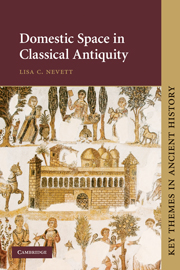Book contents
- Frontmatter
- Contents
- List of figures
- List of plates
- Preface and acknowledgements
- Map showing the locations of the sites and regions discussed in Chapters 3–6
- Introduction
- 1 Domestic space and social organisation
- 2 House-form and social complexity: the transformation of Early Iron Age Greece
- 3 A space for ‘hurling the furniture’? Architecture and the development of Greek domestic symposia
- 4 Housing and cultural identity: Delos, between Greece and Rome
- 5 Seeking the domus behind the dominus in Roman Pompeii: artefact distributions as evidence for the various social groups
- 6 Housing as symbol: elite self-presentation in North Africa under Roman rule
- Epilogue: domestic space and social organisation in Classical Antiquity
- Glossary
- Period names and dates referred to in this book
- Bibliographic essay
- Bibliography
- Index
Epilogue: domestic space and social organisation in Classical Antiquity
Published online by Cambridge University Press: 05 August 2012
- Frontmatter
- Contents
- List of figures
- List of plates
- Preface and acknowledgements
- Map showing the locations of the sites and regions discussed in Chapters 3–6
- Introduction
- 1 Domestic space and social organisation
- 2 House-form and social complexity: the transformation of Early Iron Age Greece
- 3 A space for ‘hurling the furniture’? Architecture and the development of Greek domestic symposia
- 4 Housing and cultural identity: Delos, between Greece and Rome
- 5 Seeking the domus behind the dominus in Roman Pompeii: artefact distributions as evidence for the various social groups
- 6 Housing as symbol: elite self-presentation in North Africa under Roman rule
- Epilogue: domestic space and social organisation in Classical Antiquity
- Glossary
- Period names and dates referred to in this book
- Bibliographic essay
- Bibliography
- Index
Summary
From ancient times the house has been understood as a microcosmos.
Norberg-Schultz 1985, 91The preceding chapters highlight the broad spectrum of different scales which can be explored from a domestic perspective, ranging from the intra-household level such as the topic of the Classical Greek symposium or the relative (in)visibility of women and slaves at Pompeii, up to issues spanning whole communities or even regions, such as the self-presentation of elites in late Roman Africa, interaction between cultures in early Roman Delos, or the development of polis society in Early Iron Age Greece. Juxtaposing these different sets of issues and evidence highlights a number of recurrent themes and offers insights, both about the societies discussed and about the strengths and weaknesses of domestic material as a source of information on ancient social life more generally.
The character of houses as buildings clearly varies considerably through space and time within the ancient world, but there are some parallels between the different case studies considered here. Activities prominently represented in the archaeological record are the storage, preparation and consumption of food and drink. Relevant evidence comes from all the locations and periods where finds have been recorded since the most numerous objects preserved tend to be pottery vessels, the majority of which were used for these purposes. In Early Iron Age Greece, in houses where household space was even minimally subdivided, one of the primary, archaeologically visible, functional distinctions drawn was between living areas and those used for food storage.
- Type
- Chapter
- Information
- Domestic Space in Classical Antiquity , pp. 142 - 149Publisher: Cambridge University PressPrint publication year: 2010



